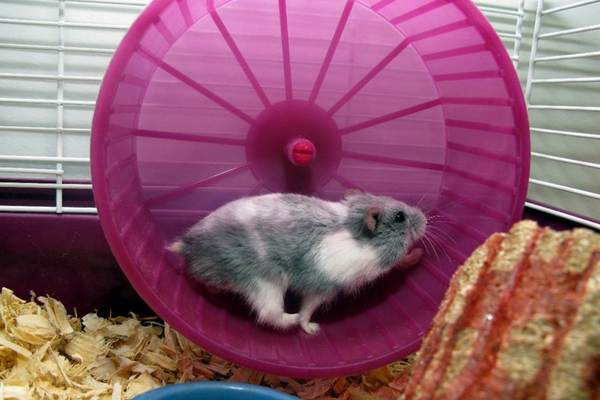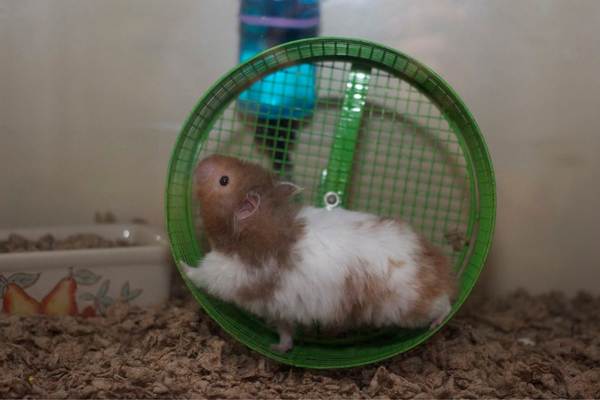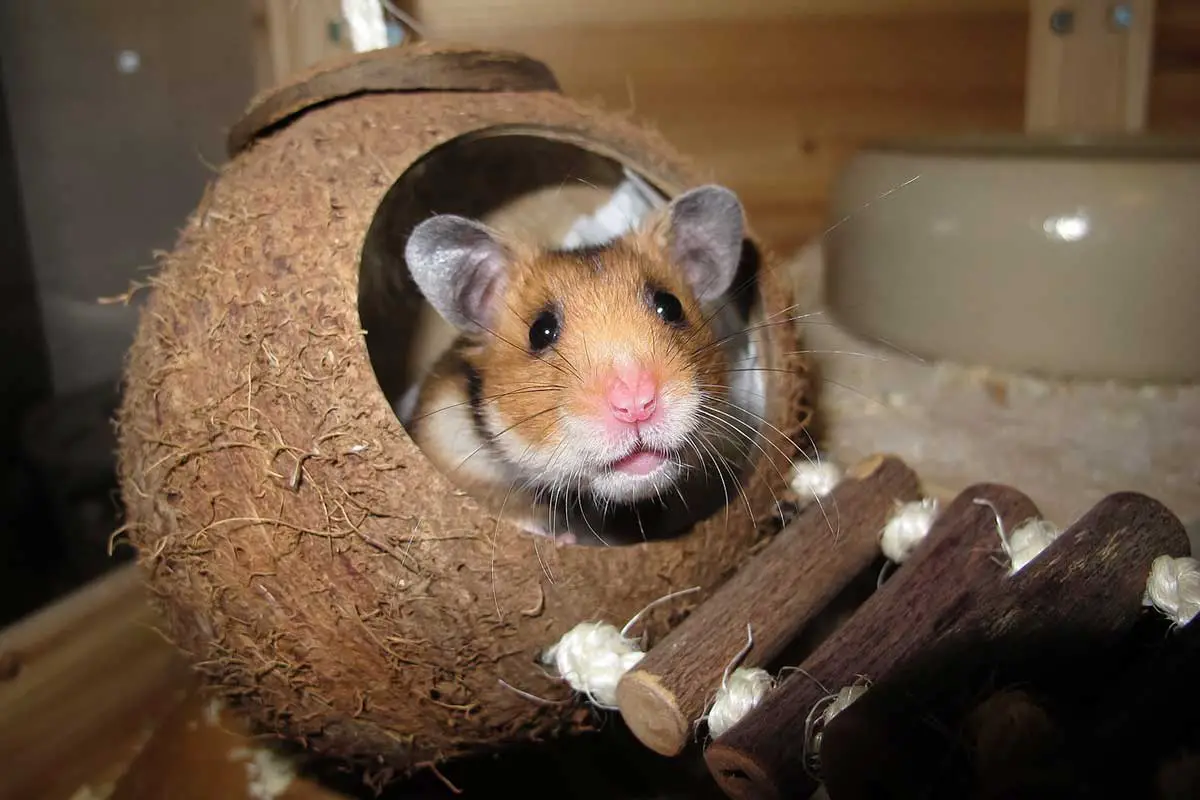Often, when people bring home a hamster, they may expect certain things like cute nibbling and cuddles. However, what many people do not expect is how much big energy is bundled into our little pocket-sized pals, so when hamsters spend inordinate amounts of time on their wheel it can be a little alarming. Worry not, however, as this behavior is almost certainly completely normal.
So, why won’t my hamster stop running in his wheel? The most likely reason is because your hamster is naturally compelled by instinct to run as much as it can. There are a few other things that could be occurring, but almost none are cause for concern.
This article will discuss your hamster’s instinctual drive to run and naturally high energy levels, the potential for restlessness and boredom, the effect sudden changes can have on behavior, as well as advancing age.
High-Powered Drive to Run

When most people think of hamsters, their minds typically do not jump to wild hamsters running free on a steppe somewhere; however, that is exactly where some of the most popular breeds now kept as domestic pets started out and continue to live to this day.
Wild hamsters inhabit steppes and plains in parts of Europe, Syria, and China, and have been domesticated for an extremely short period of time, even in comparison to other rodents and small mammals.
They did not make their appearance in the pet market until the early-to-mid 1900s, which means that any instincts the domestic hamster possesses are likely to be just as strong as their wild cousins, including the desire to run.
There are plenty of reasons that hamsters run on their wheels, but the main driving reason is because it is their instinct to do so. In the wild, hamsters are “hoarders,” meaning they spend all day scampering and running around their territory searching for food to shove into their big cheeks and bring back home.
They are also burrowers; they spend a lot of time digging maze-like burrows and subsequently running through them to distribute their hoarded food or to dig even more.
While there is no solid scientific consensus on how long hamsters run in the wild, it is generally thought that domestic hamsters can run in their wheels approximately five-and-a-half miles in one night. That is a long way to go for such tiny legs!
In addition to being instinctually driven to run, hamsters live on a remarkably high-energy diet and simply need to burn that energy off somehow. In the wild, hamsters eat grasses, nuts, seeds, and grains, and since they are omnivorous (meaning they eat both plants and animals) they even eat insects and small reptiles or amphibians!
While our pocket-sized pals at home may not be eating lizards or frogs, their diets are at least somewhat similar. Grass hay such as timothy hay, specialized pellets, nuts, seeds, grains, cracked corn, and a variety of fresh vegetables, fruits, and legumes keeps these furry fellows energized and ready to run.
Because of its instincts and high-powered diet, your hamster is basically wired to be extremely busy which is normal and no cause for concern. Outside of being naturally driven to run, it may be that your busy-bodied pal could be getting a little bored.
Restlessness and Boredom

Hamsters are naturally extremely high-energy animals, which stems largely from their previously described burrowing and food-hoarding habits coupled with their diet. Additionally, like many other rodents and small mammals, their incisors (those big front teeth they use to chew everything) are open rooted, meaning they grow continuously throughout the hamster’s life.
Because their big chompers are always growing, hamsters must always have something available to chew on. In the wild, this is largely achieved by a hamster’s natural diet. Domestic hamsters, however, may need some help in the form of chewing blocks and toys.
If you recently brought your hamster home and it is running nonstop in its wheel, or if your previously otherwise-occupied friend started its crazed marathons seemingly out of nowhere, it might simply be bored or restless. Hamsters are serious busy-bodies and need a lot of stimulation.
Ensure your furry friend’s enclosure is large and diverse enough to keep it occupied. If you have not already, consider giving your companion more toys or chew blocks and try adding some additional levels or tubes to its habitat to give it other ways to burn off all that built-up energy.
Furthermore, a great way to help your companion get out of its running rut is to give it a hamster ball! A hamster ball is exactly what it sounds like—a big ball with vents that your pet gets into so it can safely roam around your home.
On top of letting your pal run around safely, hamster balls are great for burning all that energy because the hamster must also push the weight of the ball around, instead of simply running.
Let your furry friend roll around in approximately 30-minute bursts—any longer can result in exhaustion or dehydration. The best part about the ball is that it satisfies your friend’s need for activity and exploration of its big world while letting you have peace of mind that it will not get lost or injured.
Depending on what breed of hamster you have in your home, some of its boredom could also stem from loneliness. Many breeds, such as the popular Syrian hamster, are solitary by nature and have even been known to be extremely aggressive toward one another, so they do best as single pets.
However, dwarf breeds like winter white Russian dwarf hamsters and Roborovski hamsters are quite social and often thrive when housed together.
If you have a dwarf breed hamster and it has suddenly changed its habits, consider whether it might need a companion to keep it company. If you do decide to get another hamster, ensure it is of the same breed and same sex before introducing it to its new housemate.
If your hamster has plenty of stimulation available to it and you suspect the behavior is out of the ordinary for your companion, think about any environmental changes that might be causing it stress.
Environmental Stressors and Changes

Image by Kira from Pixabay
As previously discussed, hamsters run for many reasons. One reason they run, kind of like us, can be due to stress. Hamsters are prey animals, meaning they are on the menu for quite a few predators in the wild, so they tend to be high-strung.
For domestic hamsters, these instincts are still quite strong and are often compounded by the regular stimuli and sounds from everyday life in a typical household such noise and activity from children and other pets.
If a hamster is feeling extra stress, it might take to its wheel too often which could result in complications such as exhaustion or sore and blistered feet. If you suspect stress may be driving this behavior, look for some of these other indicators:
- General hyperactivity
- Uncharacteristic behavior (bar or water bottle biting)
- Aggressiveness
- Hair loss
- Snorting or grunting
- Persistent escape attempts
- Tense or quivering muscles
On top of the everyday goings-on in our homes, the changes we make to and around our furry friend’s environment can easily cause stress as well. If you have recently moved, changed your companion’s habitat, or suddenly switched over its main food without transition, it might be feeling a little jarred by the change.
Chances are your hamster simply needs time to adjust to the changes, but keep in mind that for such a small, naturally nervous animal, some scares could cause real, physical harm. If you have made any changes like these in your home or plan to soon, try slowly transitioning your pal to the new arrangements so it has time to adjust.
There are plenty of ways to mitigate these stressors for your companion, including taking things slowly as mentioned above.
Additionally, having plenty of stimulation available to your hamster is not only a good way to combat boredom, but it can also greatly reduce stress for your pocket-sized pal. Finally, always make sure your friend inhabits a properly sized and thoroughly cleaned enclosure to keep it happy and healthy.
If you suspect your furry friend’s behavior is not driven by environmental stressors, boredom, or its natural inclination to run, there may be one more possibility to consider.
Age
Unfortunately, hamsters have quite a short life span compared to our other domestic companions such as dogs and cats. Depending on the breed, under the best of circumstances many hamsters only live between two to four years.
They do not always necessarily show their age, however, meaning if your hamster is in its golden years, it could change its activity pattern seemingly out of nowhere.
This may look like nesting or hiding out more often, hoarding more food, or perhaps even running on its wheel more often. If you suspect this may be the case, the best thing to do is give your pal lots of cuddles and attention and enjoy your special bond.
Conclusion
If you have a hamster who is a persistent and enthusiastic runner, it is likely because your pal is naturally inclined to do so due to its instincts and diet. Additionally, restlessness or boredom might be affecting your busy-bodied companion, in which case extra enrichment or time out of its enclosure in a ball might be the cure.
There are a few environmental factors to account for to ensure your friend is not suffering under too much stress, but you can easily calm it in a variety of ways. Finally, advanced age may be getting the best of your hamster, so try to fully enjoy its golden years.
In almost any case, your happy, healthy hamster running marathons on its wheel is likely no cause for great concern, so enjoy the love and entertainment you get from your tiny, furry friend in peace.

